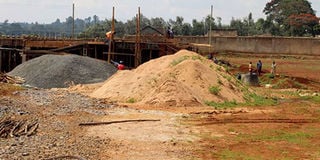Nothing to show for Sh109m spent on Manga Stadium

Stalled construction work at Manga Stadium in this photo taken on May 23, 2020. PHOTO | BENSON AYIENDA |
What you need to know:
- Governor John Nyagarama, who is serving his second and final term, has been at pains to explain why the stadium is incomplete. He has since requested financial support from the national government, saying the devolved unit lacks adequate funds to complete the stalled facility.
- "As a county government, we have tried our best but constructing the stadium requires a lot of money which we do not have at the moment," he said.
Some Sh109 million has been pumped into the construction of Manga Stadium in Nyamira County since 2014, but there is nothing to show for it.
A visit to the facility that was meant to be constructed from the ground up to international standards in the talent-rich region shows that very little work has been done.
Six years later, only a fence and a foundation stone for the construction of the main pavilion is all that stands on the parcel of land measuring roughly eight hectares where the stadium ought to have been.
Nyamira County is home to athletics legends, among them Charles Asati and the late Robert Ouko, both members of Kenya’s 4x400 metres relay team that won the first Olympic gold medal for the country at the 1972 Munich Olympic Games.
The other two athletes who were in the team are Hezekiah Nyamao from Kisii County and the late Julius Sang from Kapsabet.
Nyamira County may not produce star athletes like Asati and Ouko because work on the only public sports facility available for use has stalled.
In the 2014-2015 financial year, the county government injected Sh63 million into the project but all the money went into fencing and drilling of a borehole at the facility, according to the county’s executive for sports, Johnston Obike.
He said another Sh10 million was used the following financial year in levelling the playing surface. Another Sh36 million was allocated to the same project in 2018-2019 financial year but surprisingly, no work was done.
According to Obike, the stadium was scheduled to be constructed in four phases over four years but the project has encountered a lot delays and the work will now be finalised in 2022.
"After completing levelling of the grounds in 2016, no contractor qualified for the other work inside the stadium and hence the project was suspended until last year when we got a qualified contractor. The contractor has been on site since July last year working on the main pavilion," Obike said.
The first phase would involve putting on of the fence, drainage system, levelling of the playing surface and drilling of boreholes and was set to take one year to completion.
The second phase of the project that was approximated to take one and half years will involve construction of the main pavilion with a capacity to accommodate 2,000 VIPs, installation of an irrigation system on the pitch and laying of a running track inside the stadium.
The the third phase of the project involved construction of six spectator stands and areas for indoor games, which was meant to take a year.
Another year would be spent in laying an artificial track inside the stadium and security lights during the fourth and final phase.

The playing surface at Manga Stadium in this photo taken on May 23, 2020. PHOTO | BENSON AYIENDA | NATION MEDIA GROUP
The tender for constructing the main pavilion, the running track and installation of irrigation and drainage system on the playing surface was awarded to Saumo Enterprise Limited Company. The company was also meant to plant grass inside the stadium.
A spot check by Nation Sport on Friday established that only fencing and levelling of the playing surface has been done and the foundation for construction of the main pavilion laid.
Angelina Moturu who is the contractor told Nation Sport at the site that she started the work in January, adding that the main pavilion will be complete in July while work on the running track and the playing surface will be completed next year.
"The county government has paid half of the money and we are determined to finish the work in the shortest time possible," she said.
She cited poor topography in the region that does not favour construction of a stadium as the main challenge. She further expressed fear that the work may delay owing to Covid-19 pandemic.
The pitch had earlier been planned to measure 51 metres by 90 metres but Football Kenya Federation (FKF) objected.
The federation and the contractor later resolved that the pitch be extended to measure 51m by 100m.
Once complete, the facility will have a main stand and a VIP area with a seating capacity for 4,000 people. There will also be two spectators stands, each with capacity for 1,400 fans. The stadium will accommodate about 10,000 people.
Other intended improvements include construction of standard changing rooms, nursing rooms and an inner perimeter fence as well as installation of security lights.
Nyamira County does not have teams in the top football leagues.
Governor John Nyagarama, who is serving his second and final term, has been at pains to explain why the stadium is incomplete. He has since requested financial support from the national government, saying the devolved unit lacks adequate funds to complete the stalled facility.
"As a county government, we have tried our best but constructing the stadium requires a lot of money which we do not have at the moment," he said.





